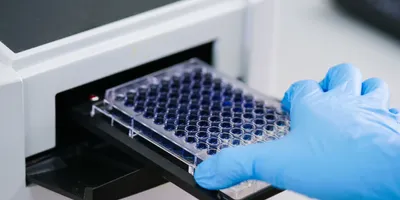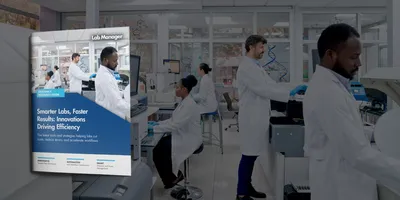Microplate readers are indispensable in life science research, drug discovery, clinical diagnostics, and environmental testing, enabling high-throughput quantification of absorbance, fluorescence, luminescence, and more. When choosing a microplate reader, labs typically face a choice between two primary options: multi-mode microplate readers and single-wavelength readers.
Each type offers distinct advantages depending on the complexity of assays, assay detection modes, budget constraints, and the lab’s throughput needs. This article compares microplate readers and single-wavelength readers, covering detection flexibility, sensitivity, cost-efficiency, and ease of use to help labs select the optimal instrument.
What is a Single-Wavelength Plate Reader?
A single-wavelength plate reader is a streamlined instrument designed to detect light at a single, fixed wavelength, typically used for absorbance assays such as ELISA, protein quantification (BCA, Bradford assays), and microbial growth monitoring.
Advantages of Single-Wavelength Readers:
- Simple Operation: Easy to use with minimal training.
- Lower Cost: More affordable initial investment.
- Ideal for Dedicated Assays: Perfect for labs running routine absorbance-based assays at one wavelength.
- Compact Size: Smaller footprint suitable for limited bench space.
Challenges of Single-Wavelength Readers:
- Limited Flexibility: Restricted to specific assays using a fixed wavelength.
- No Multi-Mode Capability: Cannot perform fluorescence or luminescence detection.
- Lower Throughput Potential: Limited to basic assays without multiplexing options.
What is a Multi-Mode Microplate Reader?
A multi-mode microplate reader supports detection across multiple wavelengths and techniques, enabling absorbance, fluorescence, luminescence, and often more advanced modes such as time-resolved fluorescence (TRF) or fluorescence polarization (FP).
Advantages of Multi-Mode Microplate Readers:
- High Flexibility: Compatible with a wide range of assay types across different research areas.
- Multi-Wavelength Detection: Supports spectral scans and multiplexed assays.
- High Sensitivity: Optimized for low-signal assays like luciferase reporter assays or qPCR.
- Automation-Friendly: Compatible with robotic systems for high-throughput screening.
Challenges of Multi-Mode Readers:
- Higher Initial Cost: Significant investment compared to single-wavelength models.
- Complex Setup: May require method development for custom assays.
- Larger Footprint: Requires more bench space.
Detection Flexibility: Matching Instrument to Assay Needs
Single-Wavelength Readers are ideal for routine assays that rely on single-wavelength absorbance measurements, such as protein quantification assays, water quality monitoring, and single-color ELISAs.
Multi-Mode Microplate Readers excel in labs running diverse assays requiring multiple detection modes, including:
- Fluorescence-based cell viability assays.
- Dual-luciferase reporter gene assays.
- Kinetic absorbance assays for enzyme kinetics.
- Multiplexed cytokine detection using fluorescence or luminescence.
✅ Verdict: Multi-mode readers offer far greater detection flexibility.
Sensitivity and Data Quality
Single-Wavelength Readers provide reliable detection for high-signal assays, where sample concentration is typically within the optimal linear range. They perform well for routine absorbance-based assays such as protein quantification (BCA or Bradford assays), ELISA tests, and water quality measurements, where the analytes are present in concentrations easily detectable via absorbance. However, these readers may struggle with ultra-low signals or samples requiring broad spectral scans, which limits their utility in applications demanding enhanced sensitivity, such as early-stage drug discovery or low-copy-number nucleic acid detection.
Multi-Mode Microplate Readers feature optimized optics and detectors for fluorescence and luminescence assays, providing exceptional sensitivity for low-concentration analytes, including biomarkers, rare proteins, and low-abundance metabolites. Advanced readers offer options like filter- or monochromator-based wavelength selection, enhancing performance for fluorescence intensity assays, time-resolved fluorescence (TRF), and luminescence-based reporter assays. This flexibility allows multi-mode readers to support applications such as gene expression analysis, cytokine profiling, and high-sensitivity enzyme assays, where low-level signals must be accurately quantified across multiple detection channels.
✅ Verdict: Multi-mode readers offer superior sensitivity, particularly for low-signal assays.
Cost and Budget Considerations
Single-Wavelength Readers are highly affordable, with entry-level systems priced between $3,000 and $8,000, making them ideal for labs with limited budgets focused on routine assays. These systems are often found in small academic labs, teaching laboratories, and quality control departments that perform basic absorbance assays on a regular basis. Their lower cost also makes them attractive for field laboratories or remote testing sites where space and budget are limited. While they lack the versatility of more advanced systems, their ease of use and reliability make them a practical choice for dedicated applications such as water quality monitoring, enzyme activity assays, and simple colorimetric assays.
Multi-Mode Microplate Readers are significantly more expensive, typically ranging from $25,000 to $100,000, depending on detection capabilities, throughput, and automation compatibility. However, their versatility can justify the cost for core facilities, pharmaceutical research centers, and biotechnology companies running a wide variety of assay types, including cell viability assays, protein-protein interaction studies, and high-throughput screening (HTS) campaigns. The ability to switch between absorbance, fluorescence, luminescence, and more specialized modes like time-resolved fluorescence (TRF) adds significant value, especially for labs engaged in assay development or method validation across multiple platforms.
✅ Verdict: Single-wavelength readers are more budget-friendly, while multi-mode readers deliver better long-term value for versatile labs.
Throughput and Automation
Single-Wavelength Readers support basic plate reading workflows, typically 96-well plates, with minimal automation options. These readers are often found in clinical diagnostic labs, teaching labs, and smaller research facilities where single-parameter assays are regularly performed. They work well for routine optical density (OD) measurements, such as microbial growth curves, enzyme kinetics assays, or ELISA tests in low-throughput environments. Due to their simplicity, they are easy to integrate into manual workflows.
Multi-Mode Microplate Readers support a wide range of plate formats, from 6-well to 384-well plates, with compatibility for liquid handlers, automated pipetting stations, and robotic automation systems, making them ideal for high-throughput screening (HTS) and drug discovery applications. In pharmaceutical R&D, these systems are essential for screening compound libraries across a variety of assay formats, including fluorescence polarization assays, dual-luciferase reporter gene assays, and multiplexed immunoassays, where multiple readouts are required from the same plate.
✅ Verdict: Multi-mode readers excel in high-throughput, automation-friendly environments.
Summary Table: Single-Wavelength vs. Multi-Mode Readers
| Factor | Single-Wavelength Reader | Multi-Mode Microplate Reader |
|---|---|---|
| Detection Modes | Absorbance only | Absorbance, fluorescence, luminescence, more |
| Sensitivity | Moderate | High for fluorescence and luminescence |
| Cost | Low | Higher initial investment |
| Flexibility | Limited | Highly flexible |
| Throughput | Low | High |
Conclusion: Choosing the Right Plate Reader for Your Lab
The decision between a single-wavelength reader and a multi-mode microplate reader depends on your lab’s assay diversity, throughput requirements, and budget.
- For labs focused on routine absorbance assays like ELISA or basic enzyme kinetics, a single-wavelength reader offers cost-effective performance.
- For labs running a wide range of assay types and requiring high sensitivity for fluorescence and luminescence-based methods, a multi-mode reader is the better long-term investment.
Many research facilities opt to combine both systems, using single-wavelength readers for routine work and multi-mode readers for specialized assays.
This content includes text that has been generated with the assistance of AI. Lab Manager’s AI policy can be found here.












